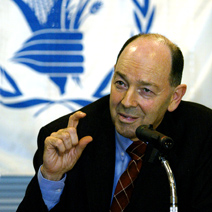
John Powell is Deputy Executive Director of the United Nations World Food Programme (WFP), the world’s largest humanitarian agency. In 2007, WFP provided food assistance to 73 million people in 78 countries, most of them women and children. In addition to feeding people in such troubled regions as Darfur, Chad, Congo, and Afghanistan, WFP aids the victims of natural disasters, families affected by HIV/AIDS, pregnant women, nursing mothers, and young children. Powell, who has been with WFP since 1990, has also worked for the World Bank and the Australian government. Gourmet Deputy Editor Jocelyn Zuckerman spoke with him about the skyrocketing prices of wheat and rice, the riots engulfing cities from Port-au-Prince to Dakar, and the short- and long-term priorities of his organization. (For more information about the World Food Programme, including details about the kinds of food the agency provides and where it comes from, visit wfp.org.)
Q. In a recent story in the New York Times, economist Jeffrey Sachs was quoted as saying the current global food crisis is “the worst of its kind in more than 30 years.” Do you agree with that, and could you talk a bit about how this crisis is different from crises your organization has faced in the past?
A. The situation that confronts the World Food Programme is essentially of two parts. The first part is the impact of high food and fuel prices on our current programs and operations. To give you a sense of what I’m talking about, at the end of 2007, these programs were estimated to cost around 2.9 billion U.S. dollars. As of today, that number has risen by 756 million U.S. dollars, purely as the result of increased fuel and food costs. There is not a single additional person reached. And the first dilemma that faces WFP is how to raise the additional resources to be able to meet the needs of people who are already among the poorest and most vulnerable in the world. And without additional support, we will simply be forced to either feed fewer people or provide less food to those people.
Q. A few weeks ago, the World Bank President, Robert Zoellick, called on the international community to coordinate its efforts and come forward with an extra $500 million. I know Bush recently came up with $200 million. Where do you stand overall?
A. The number 500 million mentioned by Zoellick is the same number as our 756, it’s just that in the intervening period, between February 25 and today, the costs have escalated further. So in terms of where we stand today, we have received contributions from a number of member states, and, for example, Spain, Germany, and a number of governments have made clear to us that they will respond to the executive director’s urgent appeal positively and very shortly. We’re in conversations with these member states, and it would really not be appropriate for me to quote specific numbers. But the response is very forthcoming.
Q. Now I want to back up a little and talk about the factors contributing to the crisis. We’ve been told it’s the result of any number of things, including the West’s increase in ethanol production, the drought in Australia, climate change, the growth of the middle classes in India and China, and the war in Iraq. Can you talk about which of those factors you think is playing the biggest role and why?
A. We see four main drivers to the soaring food prices. The first is the sharp increase in fuel and energy costs, which has an effect on every step in the value chain of agricultural production, whether it be diesel, fertilizer, seed, et cetera.
Factor number two, of course, relates to economic growth, particularly in Asia (led by China), and this is essentially brought about by a change in consumption patterns. As citizens in these countries have increased their domestic income, their dietary habits have changed, and this has affected food markets: As your income rises, you tend to eat, say, more beef than maize, and typically about eight kilos of maize converts into one kilo of beef, so that’s the kind of chain we’re talking about.
The third element is climate. This crop year, for example, we have the impact of drought in Australia, hurricanes in Central America, and so on. This is a cause for increasing concern, because the number and frequency of climate-related events—and the numbers of people affected by them—have increased sharply over past decades. The number of natural disasters has quadrupled, for example, and the number of people affected used to be 160 million in the 1980s, typically; it’s up to 250 million now, just to give you an order of magnitude. And the compelling point is really that 98 percent of the people who are affected live in the developing world.


 Pinterest
Pinterest


